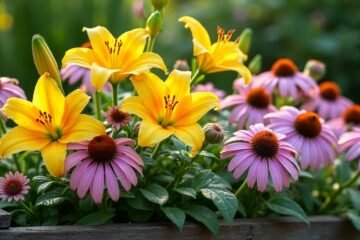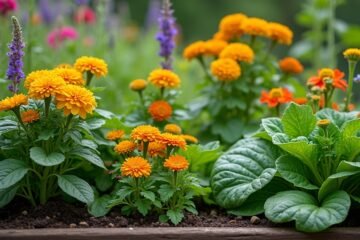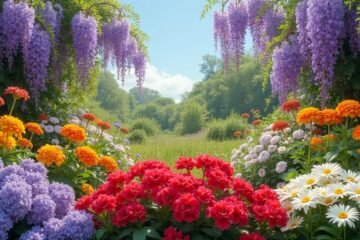Want to invite pollinators into your garden? Start by choosing native plants that thrive in your area, like vibrant milkweed for butterflies and cheerful coneflowers for buzzing bees! Mix in different heights—shrubbery and trees—along with a riot of colors to keep your garden lively! Don’t forget to offer a revitalizing water source, like a cute birdbath filled with pebbles. With these fun strategies, your garden will become a buzzing paradise! What’s next on your pollinator adventure?
Choose Native Plants
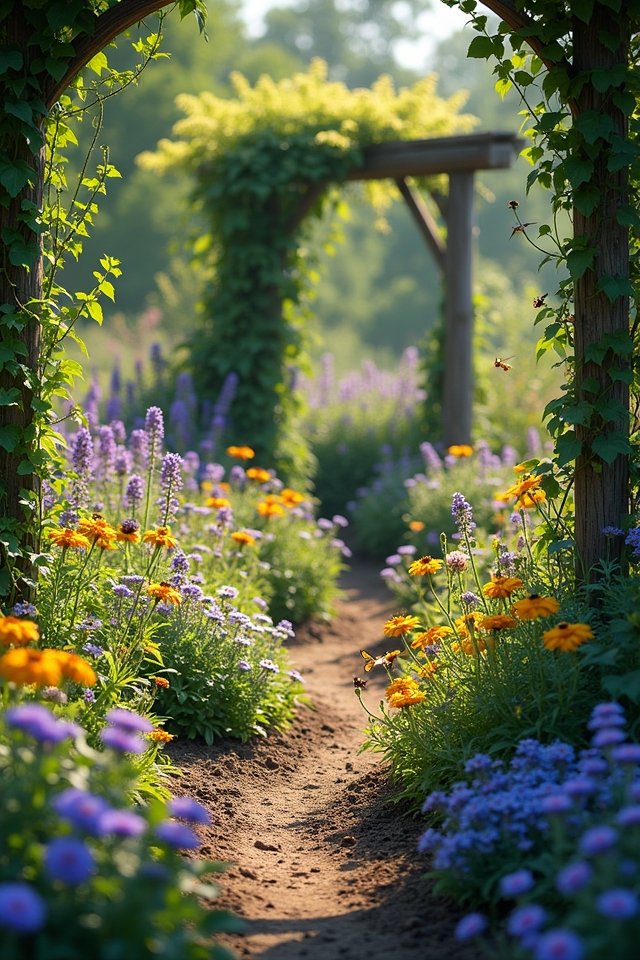
When it comes to inviting pollinators into your garden, native plants are like a warm hug for the local buzzers! These beautiful locals have a knack for thriving in your region’s unique climate, making plant selection a breeze. Imagine vibrant milkweed flamboyantly waving its bright blooms, attracting fluttering monarchs ready for a snack. Think about coneflowers standing tall, their purple petals beckoning bees like an all-you-can-eat buffet! By choosing plants that are regionally adapted, you’re not just beautifying your garden; you’re creating a haven for these essential critters. It’s a win-win! Plus, you’ll impress your friends with your eco-savvy choices. So why wait? Immerse yourself in your local flora and give those pollinators exactly what they love!
Create Diverse Planting Habitats

Just because you’re inviting pollinators doesn’t mean you need to stick with a single plant type! Imagine a vibrant patchwork of colors and textures, where every layer of planting comes alive with buzzing life! Consider including low-growing flowers, mid-height shrubs, and tall trees to create dynamic planting layers. Each layer offers habitat variety that attracts different pollinators. For instance, a sunny, herb-filled ground can lure bees, while a cluster of butterfly bushes stretches tall for fluttering friends. Think about cultivating an edible garden, too! The sweet scents of fruit trees mixed with wave-like lavender can make your garden irresistible. Why settle for boring when you can create a pollinator paradise? Let your creativity bloom!🏵
Provide Continuous Blooming Flowers
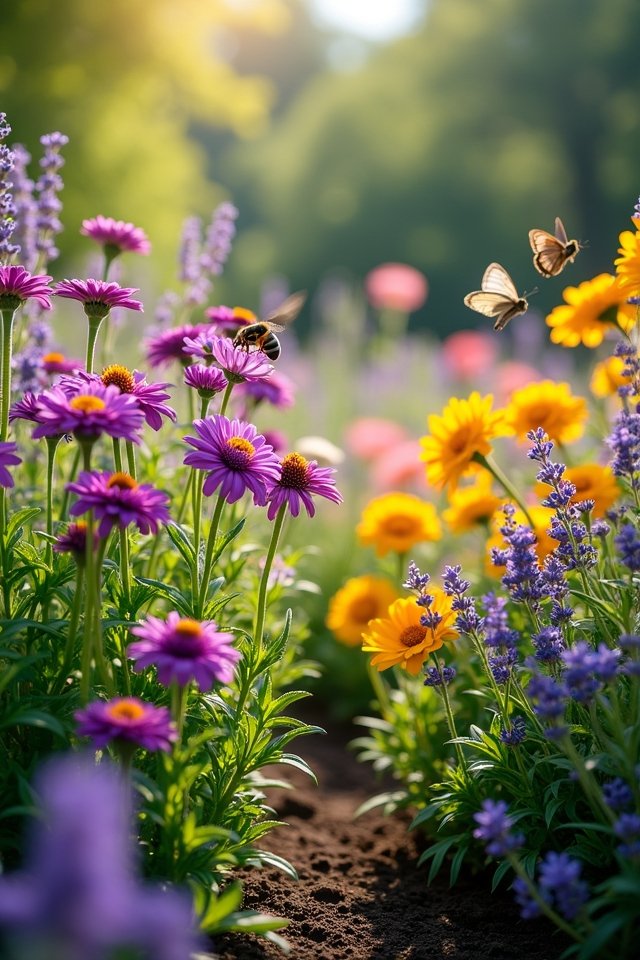
To keep your garden alive and buzzing, you’ve got to think about blooming flowers that thrive in all seasons! Seasonal blooms are essential, so why not experiment with flower rotation? Imagine your garden as a theater, where each flower takes a turn to shine in the spotlight! Start with cheerful daffodils in spring, then follow up with vibrant summer sunflowers. As autumn approaches, invite asters to dazzle our buzzing friends! This continuous show keeps pollinators excited, allowing them to feast on nectar while blooming at different times. And who wouldn’t want their yard to be the talk of the town with such an eye-catching display? Keep those flowers coming, and watch your garden transform into a haven for bees and butterflies!
Incorporate Specific Pollinator-Friendly Plants
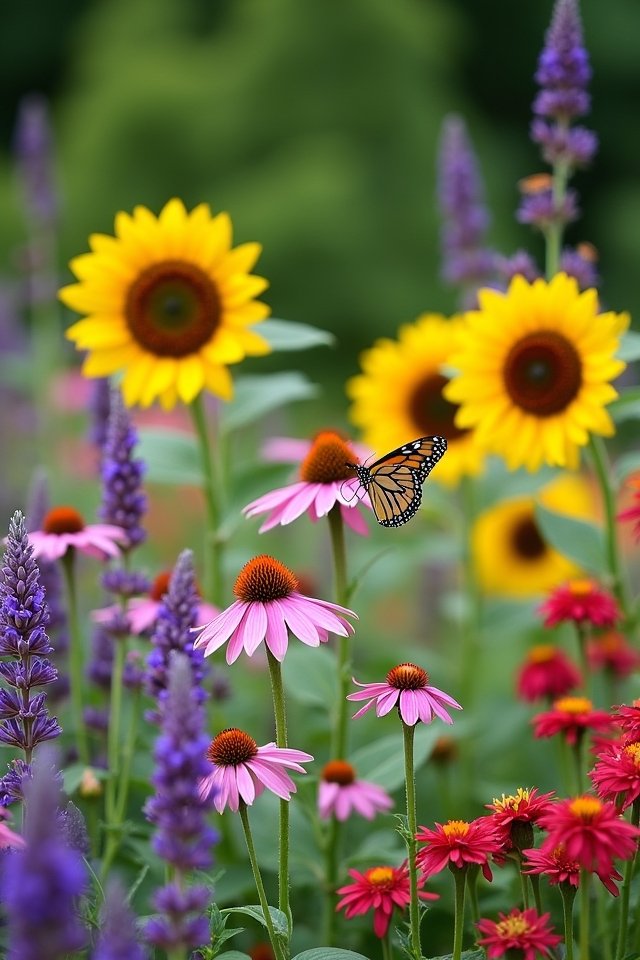
While diving into the world of pollinator-friendly plants, you’ll soon discover that not all flowers are created equal! Think of your garden as a buzzing buffet of herbaceous perennials and vibrant flowering shrubs. Plants like butterfly bush and native milkweed are irresistible to butterflies, while lavender and bee balm are like candy for bees! Imagine those mystical pollinators dancing among the blooms, sipping nectar like kids in a candy store! Don’t forget about the goldenrod—it’s a winter feast for late-season pollinators. By thoughtfully selecting these enticing plants, you’re not just beautifying your space; you’re creating a thriving ecosystem! So, why not let your garden become the hottest pollinator spot in the neighborhood? They’ll love you for it!
Utilize Color and Fragrance
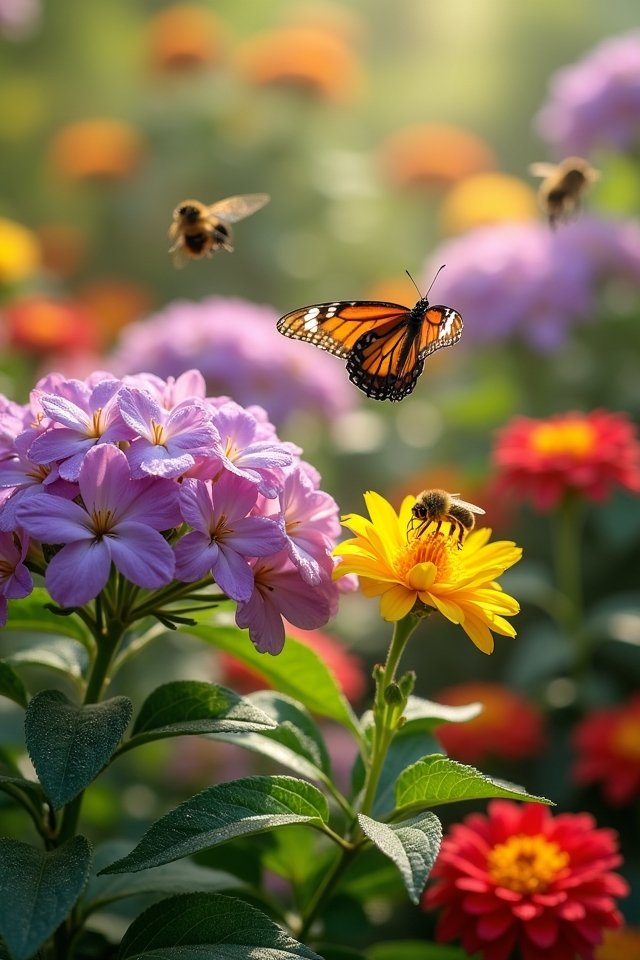
Planting a garden filled with pollinator-friendly blooms is only half the fun! Now, let’s make it a feast for the eyes and senses! You can create stunning color combinations like vibrant yellows and rich purples, attracting bees and butterflies like a magnet. Think about planting bright sunflowers next to deep blue delphiniums.
But don’t forget about fragrance! Incorporate delightful fragrance types like sweet lavender or zesty mint. Pollinators are like us—they’re drawn to inviting scents! Imagine stepping into your garden and being greeted by a symphony of colors and delicious aromas. It’s like a party, and everyone’s invited! So, get creative with your blooms and let your garden be the ultimate pollinator hangout. Who wouldn’t love that?
Ensure Water Sources Are Available
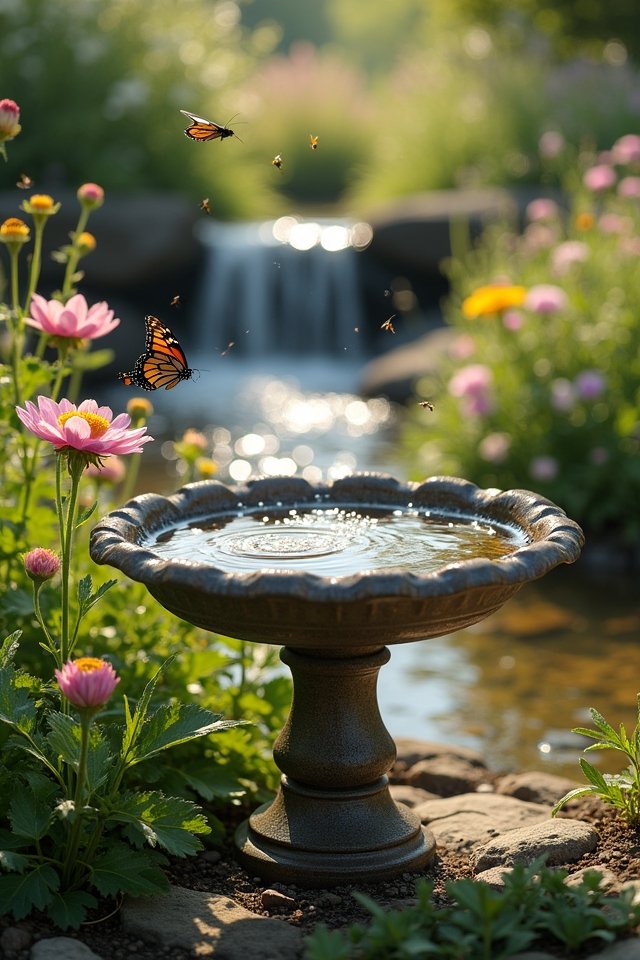
Just as a cozy café needs a warm cup of coffee, your garden requires water sources to keep those buzzing pollinators happy! Imagine a delicate bee sipping invigoratingly cool water on a sun-drenched day or a butterfly fluttering down for a drink. Ensuring ample water sources boosts water quality and fosters a vibrant ecosystem.
- Keep birdbaths filled, using pebbles for safe landing spots!
- Create small puddles in container gardens to attract thirsty visitors.
- Add a repurposed jar or shallow dish with marbles for style and substance.
Avoid Pesticides and Chemicals
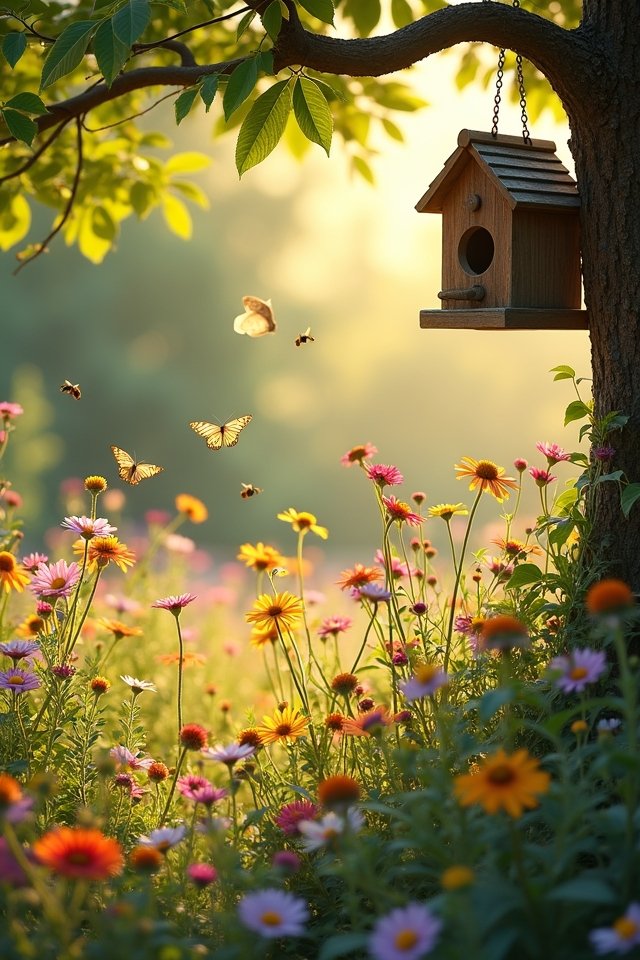
When you care about your garden as much as the inviting blooms, those tiny, buzzing pollinators do too! To guarantee their fluttering friends thrive, ditch the pesticides and chemicals. Think of your garden as a vibrant ecosystem, where every plant and insect plays a role. Adopt organic gardening by using natural alternatives instead! For example, sprinkle diatomaceous earth or use essential oils to deter pesky insects without harming helpful ones. Also, attract pollinators with companion planting—create a floral buffet of marigolds and lavender that entice bees and butterflies alike. Isn’t it exciting to nurture a garden that’s both beautiful and bee-friendly? By choosing this green path, you’ll cultivate a sanctuary that hums with life and color!
Create Shelter and Nesting Sites
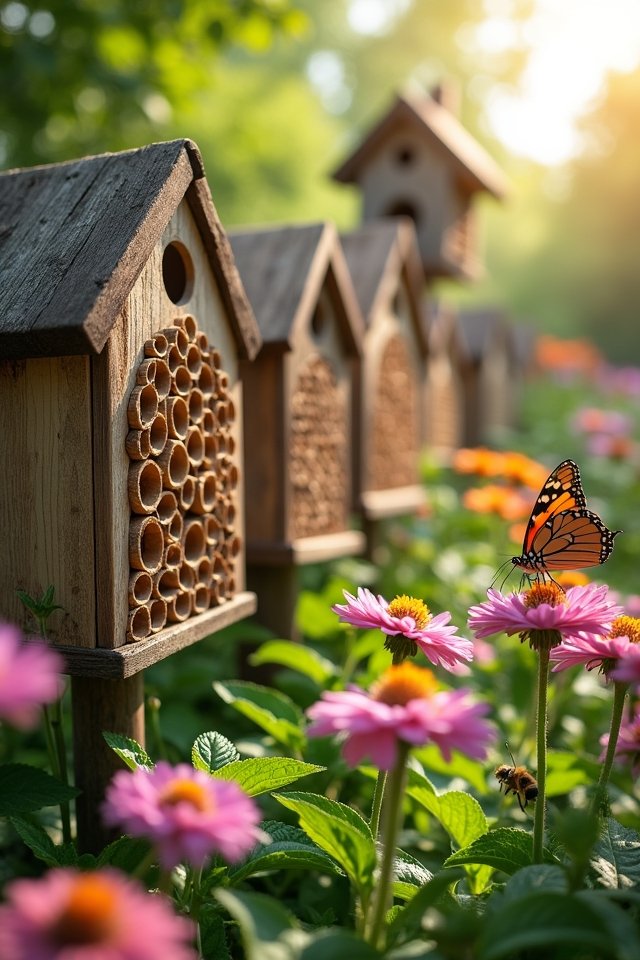
To help nature’s little helpers feel right at home, you need to create cozy shelters and nesting sites! Think of it as inviting your friends over for a cozy movie night—everyone appreciates a comfy spot!
- Build bee hotels using hollow bamboo sticks or untreated wood.
- Stack rocks and logs in your garden—they’re perfect for insects to hide and lay eggs!
- Use natural materials like twigs, leaves, and straw to craft charming nooks.
These creative additions turn your garden into a buzzing paradise! Picture colorful bees happily buzzing along while finding refuge among fragrant flowers. Who wouldn’t want to be part of that excitement? By crafting shelters, you’re not just beautifying your space, you’re also becoming a true pollinator ally! Isn’t that great?
Frequently Asked Questions
How Long Does It Take to Attract Pollinators to My Garden?
It usually takes a few weeks to attract pollinators to your garden! Think about creating pollinator habitats with vibrant flowers and rich plant diversity. Imagine a kaleidoscope of colors inviting butterflies and bees! Planting diverse blooms that flower at different times guarantees a continuous buffet for these busy helpers. They’ll flock to your garden like kids to a candy store! Get ready for the buzz; nature’s little friends will soon be buzzing your way!
Can I Use Hybrid Plants to Invite Pollinators?
Absolutely, you can use hybrid plants to invite pollinators! Think of them as the dazzling stars of your garden. While hybrid plants can be stunning, they might not always cater to pollinator preferences. Plants like the vibrant ‘Bee Balm’ or ‘Lavender’ hybrids are crowd-pleasers that draw in honeybees. Just keep in mind, some hybrids may lack the nectar that their wild cousins offer. It’s a balancing act, but the buzz is worth it!
Are There Seasonal Pollinators That Need Specific Plants?
Seasonal pollinators absolutely crave specific plants. Imagine this: your garden alive with native plants like coneflowers in summer, beckoning those busy bees. Each season offers a feast! In spring, bright blooms like buttercups attract early pollinators, while fall’s asters keep the buzz going. Isn’t it amazing how perfectly nature aligns? So, plant strategically, and watch your garden thrive with fluttering wings and buzzing energy! Isn’t that a sight to behold?
How Do I Know if My Plants Are Attracting Pollinators?
Ever wondered why those bees buzz past your window? Start by observing your garden’s activity! If you’ve planted a vibrant variety of blooms—like zinnias and lavender—you’re likely attracting pollinators. Watch for fluttering wings and bustling bees, maybe even a cheeky butterfly or two! Pollinator identification can be simple; a quick app can help. If you see them sipping nectar, you know you’re on the right track! Isn’t nature just magical?
What Is the Best Time of Day to Observe Pollinators?
You’ll want to do your morning observations, when pollinators are buzzing with energy and flowers burst into bloom under the golden sun. Usually, they’re more active early in the day, darting around with purpose! However, don’t overlook evening activity, as some species, like moths, come alive when the sun dips. Imagine the twinkling dusk, a parade of fascinating critters dancing through your garden. It’s the perfect time for nature’s show!
